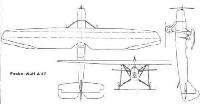
Focke-Wulf Fw 47
Разработанный по заданию метеослужбы Германии, прототип A 47 выполнил первый полет в июне 1931 года под управлением Корнелиуса Эдцарда. Оснащенный мотором As 10 самолет A-47 являл собой моноплан-парасоль с крылом деревянной конструкции и фюзеляжем с каркасом из труб и полотняной обшивкой. Самолет интенсивно испытывался в "Reichsverband der Deutschen Luftfahrtindustrie" (предшественник Федерации предприятий авиационной промышленности Германии, BDLI), а с декабря 1932 года проходил эксплуатационные испытания в метеоцентре Гамбурга. После успешного завершения испытаний поступил заказ на серийные самолеты. Серийное производство продолжалось с 1934 по 1936 год. Самолеты использовались метеослужбой Германии.
Варианты
Fw 47C: первый серийный вариант с радиостанцией, установлен ветровой козырек перед второй кабиной, использован мотор As 10c
Fw 47M: построено не менее 11 самолетов в январе - апреле 1938 года, оснащены мотором Argus As 10e; минимум один самолет имел лыжное шасси
ТАКТИКО-ТЕХНИЧЕСКИЕ ХАРАКТЕРИСТИКИ
Focke-Wulf Fw 47C
Тип: двухместный разведчик погоды
Силовая установка: один 8-цилиндровый V-образный мотор с перевернутым блоком цилиндров Argus As 10C мощностью 240 л. с. (179 кВт)
Летные характеристики: максимальная скорость 190 км/ч; практический потолок 5600 м; дальность полета 640 км
Масса: пустого 1065 кг; максимальная взлетная 1580 кг
Размеры: размах крыла 17,75 м; длина 10,55 м; высота 3,04 м
Описание:
- Focke-Wulf Fw 47
- Flight, December 1932
FOR METEOROLOGICAL OBSERVATIONS
Фотографии
-
Flight 1932-12 / Flight
Регистрационный номер: D-2295 -
Мировая Авиация 132
Регистрационный номер: D-IGYH, D-INYP, D-IPIN, D-IREZ Благодаря крылу типа парасоль Fw 47 обладал довольно необычным внешним видом. Самолет специально спроектирован для разведки погоды согласно требованиям метеослужбы Германии.
-
Flight 1932-12 / Flight
THE PILOT'S COCKPIT: The instrument equipment is unusually extensive. Below and to the right of the wheel can be seen the oil temperature control handle.
-
Flight 1932-12 / Flight
Focke-Wulf A 47
- Фотографии



